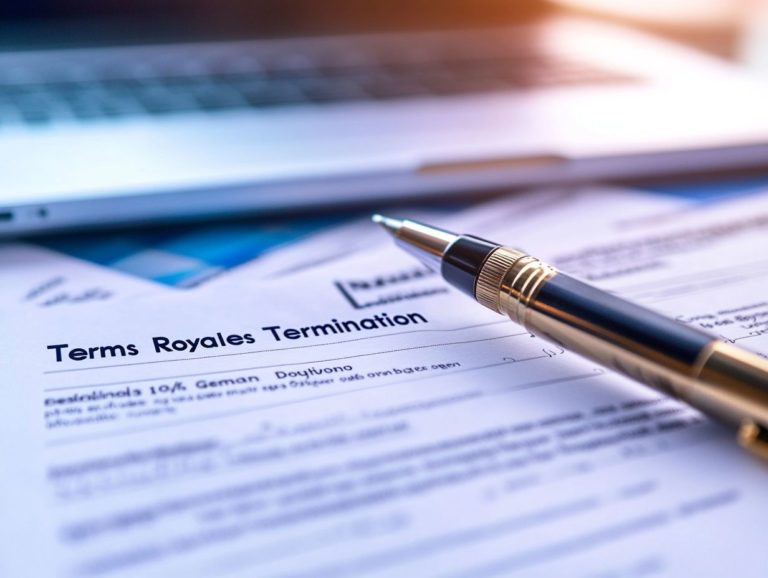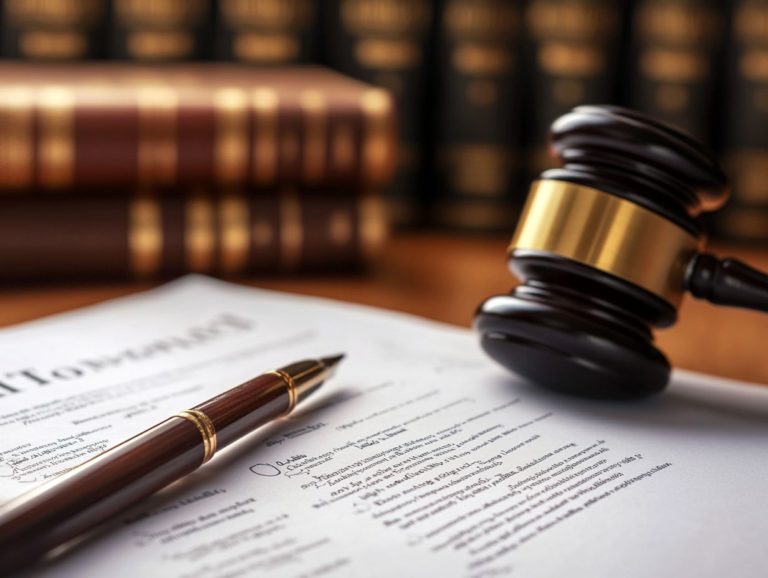How to Manage Multiple Licensing Agreements
In today’s interconnected business landscape, licensing agreements are essential for safeguarding your intellectual property and fostering collaboration. Don’t miss out on key insights to protect your innovations!
Managing multiple agreements can often feel overwhelming, presenting challenges like common pitfalls and compliance issues.
This article delves into the significance and advantages of these agreements, offering you effective strategies for efficient management and valuable tips for successful negotiations.
By addressing potential conflicts and ensuring compliance, you will find a clear path to navigate the complexities of licensing with confidence.
Dive in to discover how to optimize your approach and protect your interests effectively.
Contents
- Key Takeaways:
- The Importance of Licensing Agreements
- Overcoming the Challenges of Managing Licensing Agreements
- Strategies for Efficient Management
- Negotiating and Renegotiating Licensing Agreements
- Ensuring Compliance with Licensing Agreements
- Dealing with Conflicting Licensing Agreements
- Frequently Asked Questions
- What are multiple licensing agreements, and how can I effectively manage them?
- What are some challenges of managing multiple licensing agreements?
- How can I avoid conflicts of interest when managing multiple licensing agreements?
- Is it possible to terminate a licensing agreement?
- How can I stay organized when managing multiple licensing agreements?
Key Takeaways:

Understand the purpose and benefits of licensing agreements to manage them effectively.
Effective organization and communication are key to overcoming challenges and roadblocks in managing multiple licensing agreements.
Use smart negotiation strategies to ensure smooth management of licensing agreements, as well as monitoring and enforcing compliance.
The Importance of Licensing Agreements
Licensing agreements are vital in the realm of intellectual property, particularly for technology companies. They facilitate the effective management of software and other digital assets while ensuring alignment with your organization s business goals.
These agreements serve to reduce compliance risks, safeguard against financial loss, and establish clear terms that protect the rights of all parties involved.
Understanding the Purpose and Benefits
Understanding the purpose and benefits of licensing agreements is crucial for you to leverage intellectual property effectively. It enables you to facilitate software license management and streamline the tracking of royalty payments, which are money paid to creators for using their work.
These agreements provide a vital framework for navigating the intricate realms of copyright, trademark, and patent protection, ensuring that the rights tied to your intellectual property remain secure.
By establishing clear terms, you can mitigate risks associated with infringement, ensuring compliance with legal standards while opening doors for revenue generation.
Licensing agreements enable you to monetize your innovations, allowing you to capitalize on your assets while retaining control over how your intellectual property is used. This smart strategy boosts your market presence and fosters partnerships that can propel growth and spark innovation.
Overcoming the Challenges of Managing Licensing Agreements
Managing multiple licensing agreements introduces complexities that can impede your ability to effectively handle compliance risks and organize document storage. Learning how to use licensing agreements for product development can help address these challenges and ultimately improve your business operations and efficiency.
Common Issues and Roadblocks
Several common issues and roadblocks can crop up when managing licensing agreements, particularly with compliance regulations and the ever-looming risk of disputes. You might find that misunderstandings about licensing terms create confusion and unwanted liabilities.
This often gets worse due to poor documentation practices; unclear records can make it nearly impossible to track changes or meet specific obligations. If your contract management systems are lacking, your organization could be exposed to costly errors.
Implement effective training programs that clarify licensing terms and promote meticulous record-keeping. Embracing robust contract management software can really streamline your processes, ensuring that all parties are aligned. This not only minimizes risks but also enhances overall compliance, giving you peace of mind.
Strategies for Efficient Management

Implementing strategies for efficient management is essential for your business. This approach enables you to create an effective organizational system that incorporates robust software management practices and a centralized inventory list for meticulously tracking licensing agreements.
By doing so, you enhance operational clarity and streamline processes, ultimately positioning your organization for success.
Best Practices for Organization and Communication
Best practices in organizing and communicating around licensing agreements are very important. They ensure clarity in software license agreements and foster effective collaboration among all parties.
Clearly outlining the terms and conditions significantly reduces misunderstandings. This lays a strong foundation for your partnership.
Implementing structured communication protocols allows for timely updates and feedback. This enhances accountability across the board.
Using collaborative tools like shared digital platforms and project management software streamlines documentation. This gives everyone easy access to relevant information.
This approach promotes transparency and encourages teamwork in handling tricky situations that may arise during the licensing term.
Negotiating and Renegotiating Licensing Agreements
Negotiating licensing agreements is essential for you as a business leader. It helps you adapt to changes while keeping your terms favorable and compliant.
Mastering this skill enhances your strategic position in the market.
Tips for Successful Negotiations
Successful negotiations hinge on solid strategies, understanding compliance, and knowing the intellectual property involved. Cultivating rapport with the other party is also essential.
When you listen actively and engage meaningfully, finding common ground becomes easier. This leads to mutually beneficial outcomes.
A recent tech industry case study showed how a team built trust with a partner by sharing valuable market insights.
Knowing specific licensing terms helps you lay out clear expectations and identify compromise areas. This ensures everyone feels valued.
Be prepared to walk away; it signals confidence and may prompt the other party to reconsider their position.
Ensuring Compliance with Licensing Agreements
You must ensure compliance with licensing agreements to protect your business from risks! This step safeguards your business and reinforces your commitment to ethical practices.
Monitoring and Enforcing Terms

Monitoring and enforcing licensing terms is crucial for safeguarding everyone’s rights. It ensures compliance with established conditions.
To achieve this, implement effective methodologies tailored to your organization’s needs. Regular audits provide insights into adherence and help identify potential discrepancies before they escalate.
Establish clear reporting systems so stakeholders can voice concerns or report violations. Embracing technology enhances these processes by automating tracking, minimizing errors, and streamlining compliance checks.
Proactive enforcement fosters a culture of accountability and trust among all parties.
Dealing with Conflicting Licensing Agreements
Navigating conflicting licensing agreements requires a structured approach. This helps you identify and resolve disputes effectively.
Clear communication ensures all parties understand their rights and obligations. It paves the way for smoother negotiations and harmonious resolutions.
Resolving Conflicts and Disputes
Resolving conflicts from licensing agreements requires skilled negotiation and a good understanding of the law. A proactive approach is key.
Open communication allows both parties to share their views freely. This understanding creates a team-friendly atmosphere for constructive dialogue.
Sometimes, a third-party mediator can help both sides find common ground. These strategies can streamline the resolution process and strengthen professional relationships.
Frequently Asked Questions
What are multiple licensing agreements, and how can I effectively manage them?
Multiple licensing agreements occur when a company or individual enters into more than one agreement with different parties to use their intellectual property, technology, or products. To manage them effectively, it’s essential to understand the terms of each agreement and refer to guides on how to stay compliant with licensing agreements while keeping track of important dates and deadlines.
What are some challenges of managing multiple licensing agreements?
Challenges include potential conflicts of interest, tracking multiple agreements simultaneously, and ensuring compliance with all legal requirements.
How can I avoid conflicts of interest when managing multiple licensing agreements?
To avoid conflicts, understand the scope of each agreement and establish protocols for handling potential issues.
Is it possible to terminate a licensing agreement?
Yes, you can terminate a licensing agreement, but the process and consequences depend on the outlined terms. Review the termination clause carefully before entering into an agreement.
How can I stay organized when managing multiple licensing agreements?
Staying organized involves creating a central database or spreadsheet to track all agreements, including important dates and obligations. Regular communication with all parties involved ensures smooth management.
If you have more questions or need help with licensing agreements, feel free to reach out!






